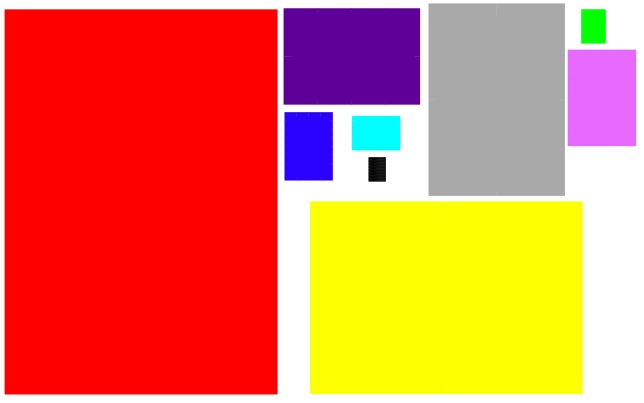Copyright © University of Cambridge. All rights reserved.
Different Sizes

You could have a go at putting these in order from the smallest to the biggest.
Do you notice anything about the way they increase in size?
What about the sides?
What about the area?
Can you arrange them in a pattern which shows doubling?
Could you draw some different pictures that also show doubling?
Now, what about HALVING? Could you make and arrangment or new picture to show halving, again and again?
Why do this problem?
This
activity is presented to enable discussion to take place about halving and doubling. It also gives an opportunity for pupils to create their own pictures, diagrams, symbols and examples of objects halving or doubling.
Possible approach
Before you begin, make some paper copies of the pieces so that each pair has a set. The picture can be printed out here (
.doc, pdf ) or you may
prefer to have them as parts of A4 here ( pdf)
Give the children some time to explore the relative sizes - this is an ideal informal opportunity, as you wander round the classroom, to listen to the language and ideas they have. Use their ideas to ask provoking questions about size, order, colour, things that are the same and things that are different. How have they arranged them?
Focus now on the language of comparative size. For example, what can they say about the red and yellow shapes? Share ideas about the lengths of sides and the areas of the shapes. Some children may talk about bigger and smaller, or longer and shorter, whilst others may recognise the doubling and halving relationships of the areas. This is quite a sophisticated concept and can be made more
evident to the children by placing shapes on top of each other.
Offer time for children to create their own pictures/models/arrangements to demonstrate doubling and halving and give them an opportunity to talk about what have they done.
Key questions
What kind of pattern can you make with the shapes?
Tell me about your pattern.
Can you show me two shapes where one is double the other? How is it doubled?
What about half of the other? How is it halved?
Possible extension
With your more able pupils you may like to present the shapes, not cut out, in this arrangement. You will find an example here (
.doc, pdf). In this
case the children will have to do some visualising in order to be able to answer your questions.
Possible support
Some children will find the concept of comparative areas difficult. For them the activity can be consolidation of the language of length.
"A" sized paper
The international paper size standard, ISO 216, is based on the German DIN 476 standard for paper sizes. ISO paper sizes are all based on a single aspect ratio of square root of 2, or approximately 1:1.4142. The base A0 size of paper is defined to have an area of one m ².
Successive paper sizes in the series A1, A2, A3, and so forth, are defined by halving the preceding paper size along the larger dimension. The most frequently used paper size is A4 210 by 297 millimetres (8.3 × 11.7 in). The significant advantage of this system is its scaling: if a sheet with sides in the ratio of $\sqrt{2}$ is divided into two equal halves parallel to its shortest sides,
then the halves will again have sides in the ratio of $\sqrt{2}$. A4 sheets are folded to make A5, A5 to A6 etc. This means that scaling doesn't compromising the ratio of the sides from one size to another””as provided by office photocopiers, e.g. enlarging A4 to A3 or reducing A3 to A4. Similarly, two sheets of A4 can be scaled down and fit exactly 1 sheet without any cutoff or
margins.
The advantages of basing a paper size upon an aspect ratio of $\sqrt{2}$ were already noted in 1786 by the German scientist and philosopher Georg Christoph Lichtenberg.[1] Early in the 20th century, Dr Walter Porstmann turned Lichtenberg's idea into a proper system of different paper sizes. Porstmann's system was introduced as a DIN standard (DIN 476) in Germany in 1922, replacing a vast
variety of other paper formats. Even today the paper sizes are called "DIN A4" in everyday use in Germany and Austria. The term Lichtenberg ratio has recently been proposed for this paper aspect ratio.
Source: Wikpedia http://en.wikipedia.org/wiki/Paper_size
